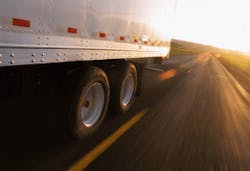WASHINGTON, D.C. Tire maker Bridgestone Americas Holding sees major challenges ahead for tire suppliers and their trucking customers alike.
“We’re seeing a huge impact from rising raw material and energy costs that aren’t slowing,” Mark Emkes, Bridgestone America’s chairman & CEO, said here during a speech at a company dealer meeting. “We expect to spend an extra $360 million this year to cover higher raw material and energy prices, which is why we’ve had to raise our tire prices.”
Singh Ahluwalia, president of Bridgestone Americas’ truck & bus tire division, noted the company had to raise tire prices twice in the last 12 months to compensate. An 8% jump came in September followed by a 5% hike last month.
“These price increases ensured we could keep our head above the water and recover the higher costs we’re paying for raw materials and energy,” Ahluwalia said at the meeting.
Despite those challenges, Emkes stressed that Bridgestone Americas is coping well. Sales in 2005 grew 11% over 2004 to $10.15 billion, with the company posting an after-tax profit of $428 million—its first annual profit in six years. (This excludes legal expenses from a settlement reached with Ford Motor Co. last October for $240 million that resolved outstanding financial issues associated with Firestone’s August 2000 voluntary safety recall and Ford’s May 2001 tire replacement program.)
Those numbers helped boost the balance sheet of its parent company, Tokyo-based Bridgestone Corp., which saw sales in ’05 climb to $22.8 billion with after-tax profit increasing 58% over ’04 to $1.53 billion, noted Asahiko “Duke” Nishiyama, president of Bridgestone Americas.
Emkes said the tire maker is challenged not only by higher raw material costs but by low-cost manufacturers importing tires into North and South America markets. He said this threat will be met Bridgestone Americas’ plan to invest $5.2 billion over the next three years to bolster its products and workforce. “That translates into $5 million a day worth of investment spending,” he said.
The company also plans to strengthen its “vertical integration” strategy, said Emkes, so it can gain control over raw material production as a way to control costs. “We bought an Indonesian rubber plantation from one of our competitors last year and we’re helping Liberian farmers – a country just now emerging from a 14-year civil war – plant runner trees so they can grow a cash crop,” he noted.
Those efforts will revitalize to the company’s future profitability plans, added Nishiyama. “Success will not be easy because many challenges lie ahead. We are facing dramatic increases in raw material costs, from astronomical increases in petroleum prices driving up the cost of synthetic rubber and carbon black to rising natural gas and natural rubber prices,” he said. “We know you are tired of hearing about this – so are we.”
The increase in low-cost offshore competition can’t be ignored either, he said. “Some of our U.S. plants are not globally competitive – and some are not profitable,” Nishiyama explained. “We can’t afford to ignore the realities of global competition and nor can the unions. But if we focus on developing a premium product and deliver value added services to our customers, the fleets, that these competitors can’t, then we’ll able to sustain profitability.”
About the Author
Sean Kilcarr
Editor in Chief
Sean Kilcarr is a former longtime FleetOwner senior editor who wrote for the publication from 2000 to 2018. He served as editor-in-chief from 2017 to 2018.
